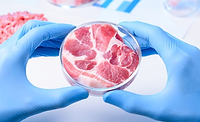Cell-Cultured
Omeat Enters Cultivated Meat Market

Photo by Austin Santaniello / Unsplash
Omeat announced its entry into the cultivated meat market, revealing an approach that reduces input costs and can be scaled to sustainably meet the global demand for beef and other types of animal protein. The process uses regenerative factors extracted humanely from healthy, living cows to derive growth media, a cost driver of cultivated meat. The media can grow beef, pork, chicken or fish.
Omeat founder & CEO Ali Khademhosseini, Ph.D., came to understand the challenges presented by conventional animal agriculture practices, and he shifted focus from growing human tissues for medical applications to developing a scalable method for growing cultivated meat.
"The conventional approach to meat production comes with major adverse effects on the environment, public health and animal welfare. We saw an opportunity to leverage our expertise to discover a scalable way to grow cultivated meat," says Khademhosseini. "The approach we uncovered and are currently scaling is a simple and elegant solution that taps into the natural biology of animals to let nature do its work. The result is real meat that's pure, delicious, and can satisfy a growing population's demand for meat in a sustainable and humane way."
Omeat sources growth media from its herd of cows that graze on its farm in California. The farm is designed to be carbon negative. It already employs several regenerative practices for soil health, including no tilling, planting cover crops, rotational grazing and natural fertilization by Omeat's free-roaming herd. Omeat's farm is planted with grasses chosen for optimal herd nutrition. The farm holds about 30,000 gallons of rainwater per acre, minimizing runoff or the need for watering.
In addition to having a full-time veterinarian on board, Omeat has worked with animal-welfare scientist Dr. Kristina Horback of UC Davis in designing its farm and approach to animal care. This work has entailed the development of processes for collecting plasma, a nutrient fluid that is the source of Omeat's proprietary growth media. Omeat's collection practices employ positive reinforcement and are designed to ensure the holistic well-being of the animals. The collection happens weekly and is similar to how humans donate plasma. Because plasma regenerates quickly, it does not deplete the animal.
Khademhosseini explains a chief benefit of Omeat's approach, "With one cow providing plasma weekly, we can create many cows' worth of meat annually. This means we can feed the planet with only a fraction of the animals used in beef production. We see ourselves as a meat company, and our goal is to be a bridge to the future of the meat industry. We're perfecting a sustainable operation that existing farms and ranches can implement, generating the same volume of product but with a fraction of the overhead. It's way more efficient, and we don't have to sacrifice the cow."
The company chose beef because it is the meat segment with the largest global land and water footprint, and it can impose a heavy burden on the environment and climate. Additionally, in research conducted by the Good Food Institute, ground beef is the cultivated meat for which consumers expressed the greatest interest.
Omeat raised an oversubscribed $40M Series A in 2022. Backers include the prominent VCs S2G Ventures, Google Ventures (GV), Bold Capital Partners, Tyson Ventures, the venture capital arm of Tyson Foods, Inc., Rethink Food, Trailhead Capital and Cavallo Ventures. The company is building a pilot plant and expanding its team toward commercial readiness. In parallel, the company is in conversations with the Food and Drug Administration (FDA) and the United States Department of Agriculture (USDA) toward regulatory approval.
Looking for a reprint of this article?
From high-res PDFs to custom plaques, order your copy today!







